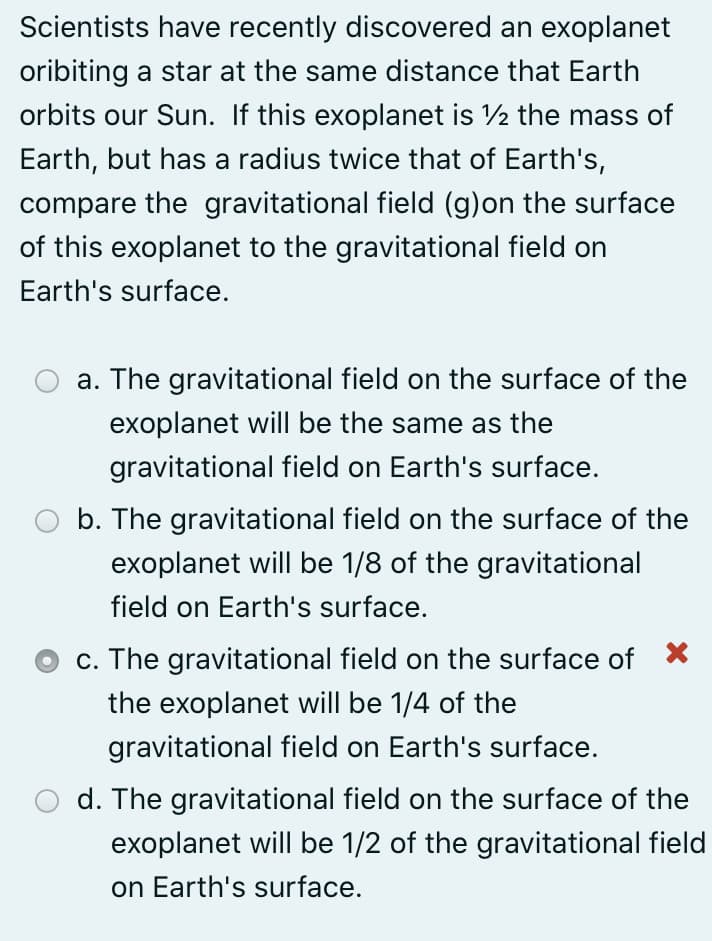Scientists have recently discovered an exoplanet oribiting a star at the same distance that Earth orbits our Sun. If this exoplanet is 2 the mass of Earth, but has a radius twice that of Earth's, compare the gravitational field (g)on the surface of this exoplanet to the gravitational field on Earth's surface. a. The gravitational field on the surface of the exoplanet will be the same as the gravitational field on Earth's surface. b. The gravitational field on the surface of the exoplanet will be 1/8 of the gravitational field on Earth's surface.
Scientists have recently discovered an exoplanet oribiting a star at the same distance that Earth orbits our Sun. If this exoplanet is 2 the mass of Earth, but has a radius twice that of Earth's, compare the gravitational field (g)on the surface of this exoplanet to the gravitational field on Earth's surface. a. The gravitational field on the surface of the exoplanet will be the same as the gravitational field on Earth's surface. b. The gravitational field on the surface of the exoplanet will be 1/8 of the gravitational field on Earth's surface.
Physics for Scientists and Engineers: Foundations and Connections
1st Edition
ISBN:9781133939146
Author:Katz, Debora M.
Publisher:Katz, Debora M.
Chapter7: Gravity
Section: Chapter Questions
Problem 45PQ: Figure P7.45 shows a picture of American astronaut Clay Anderson experiencing weightlessness on...
Related questions
Question
Can I please get help

Transcribed Image Text:Scientists have recently discovered an exoplanet
oribiting a star at the same distance that Earth
orbits our Sun. If this exoplanet is V2 the mass of
Earth, but has a radius twice that of Earth's,
compare the gravitational field (g)on the surface
of this exoplanet to the gravitational field on
Earth's surface.
a. The gravitational field on the surface of the
exoplanet will be the same as the
gravitational field on Earth's surface.
b. The gravitational field on the surface of the
exoplanet will be 1/8 of the gravitational
field on Earth's surface.
c. The gravitational field on the surface of
the exoplanet will be 1/4 of the
gravitational field on Earth's surface.
d. The gravitational field on the surface of the
exoplanet will be 1/2 of the gravitational field
on Earth's surface.
Expert Solution
This question has been solved!
Explore an expertly crafted, step-by-step solution for a thorough understanding of key concepts.
Step by step
Solved in 3 steps

Knowledge Booster
Learn more about
Need a deep-dive on the concept behind this application? Look no further. Learn more about this topic, physics and related others by exploring similar questions and additional content below.Recommended textbooks for you

Physics for Scientists and Engineers: Foundations…
Physics
ISBN:
9781133939146
Author:
Katz, Debora M.
Publisher:
Cengage Learning

University Physics Volume 1
Physics
ISBN:
9781938168277
Author:
William Moebs, Samuel J. Ling, Jeff Sanny
Publisher:
OpenStax - Rice University

College Physics
Physics
ISBN:
9781305952300
Author:
Raymond A. Serway, Chris Vuille
Publisher:
Cengage Learning

Physics for Scientists and Engineers: Foundations…
Physics
ISBN:
9781133939146
Author:
Katz, Debora M.
Publisher:
Cengage Learning

University Physics Volume 1
Physics
ISBN:
9781938168277
Author:
William Moebs, Samuel J. Ling, Jeff Sanny
Publisher:
OpenStax - Rice University

College Physics
Physics
ISBN:
9781305952300
Author:
Raymond A. Serway, Chris Vuille
Publisher:
Cengage Learning

Principles of Physics: A Calculus-Based Text
Physics
ISBN:
9781133104261
Author:
Raymond A. Serway, John W. Jewett
Publisher:
Cengage Learning

Glencoe Physics: Principles and Problems, Student…
Physics
ISBN:
9780078807213
Author:
Paul W. Zitzewitz
Publisher:
Glencoe/McGraw-Hill

Astronomy
Physics
ISBN:
9781938168284
Author:
Andrew Fraknoi; David Morrison; Sidney C. Wolff
Publisher:
OpenStax